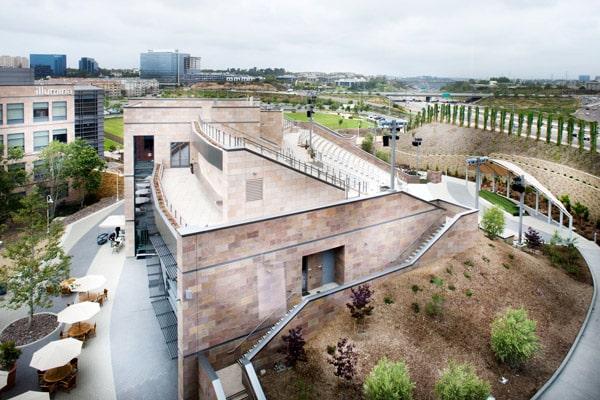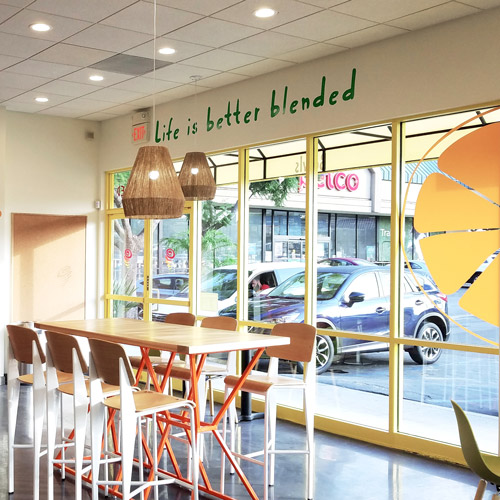Illumina’s blueprint for progress depends on its physical spaces as much as its scientific breakthroughs. For Leizl Jones, director of global facilities management and operations, site development must outpace Illumina’s high-growth mode—and it’s not an easy task.
The billion-dollar company fills about 2.3 million square feet among 12 offices worldwide. With expanded headquarters in California and new buildings on the way, Jones ensures Illumina’s teams have more room than ever to solve the genetic mysteries in health and disease.
But when Jones joined Illumina 10 years ago, it was a much leaner company. Founded in 1998, the biotech start-up operated with about 300 employees in a few random buildings along one road in San Diego. The arrival of Jones in 2008 initiated the first facility planner role at the company, which previously lacked space management tools.
“At the time, they were really skeptical about the position,” Jones recalls. “Before, they would go around and just look for empty seats, so I had a unique opportunity to not only grow my own role, but also grow a higher function, which is now the facilities planning team.”
Jones started with a spreadsheet to formally identify who’s sitting where, managing the open space, and meeting with leaders to get their CAD drawings to strategize Illumina’s expansion plan.
“We started tracking our capacity at the year and five-year increments in a chart, and the executive team could see that we were going to quickly outgrow the current building,” Jones says. “It caught their attention, and we began to pursue other campuses.”
To this day, Illumina’s growth trajectory continues to incline: it employs more than 5,500 people in Brazil, Netherlands, China, Singapore, Japan, Australia, the United Kingdom, and the United States. As a pioneer in human health, the company’s DNA sequencing tools produce almost 90 percent of the world’s data and, last year, the US Small Business Administration honored Illumina with a lifetime achievement award in innovation research and extraordinary success.

Jones knows how to perpetuate that success by accommodating Illumina’s rapidly growing numbers. Her team devises a strategic plan for each facility, overseeing real estate, construction, management, and operations to maximize efficient use of each space.
“Now you can find any employee in the company, and there is a seating location that you can trace back into a map,” she says. All of this work supports the teams making genetic testing accessible to the public.
While government-funded scientists first sequenced the human genome (the complete set of DNA in the body) in 2003 after 13 years and $3 billion, Illumina’s HiSeq X product cut sequencing costs to $1,000 in 2014. And the disruption continues: now Illumina’s NovaSeq technology decodes DNA at a much faster rate—sets of 60 human genomes in about 60 hours—and aims to eventually do it for $100 or less.
That ambition is attainable with the right talent—and Jones knows that with more human capital, more office space is needed. That’s where she applies her expertise. Prior to Illumina, Jones worked at Agouron Pharmaceuticals (now a subsidiary of Pfizer), which produced treatments for HIV infection. During her 16-year tenure, she worked her way up to facilities management as associate director before joining Illumina as its senior manager of global facilities services preceding her promotion to the department director.
There’s no better evidence of Jones’s thumbprint on the blueprints of Illumina than the transformation of its worldwide headquarters—from a few scattered offices on a single street into the expansive San Diego campus that Illumina moved into in 2011.
Prior to the relocation, Jones and her team of consultants and architects had put together a strategic facilities plan to articulate the vision.
“We were growing our headcount by 10–15 percent. We were in high growth, and still are, and it became obvious that we were going to be out of space,” she says. Jones and her team considered the ramifications of staying put, but attempting to squeeze people into the space became unrealistic. Then, they looked at acquiring more buildings as they became available nearby, but discovered most were tied up with other tenants.
Jones concluded that Illumina needed a new location that offered enough space to scale and grow operations, and the San Diego campus fit the bill. And, true to growth expectations, Illumina constructed four new on-site buildings in the last six years: a 127,000-square-foot laboratory and office building, a parking structure, a 23,000-square-foot fitness and amphitheater building, and a 300,000-square-foot manufacturing and distribution building.
“We are a 100 percent open plan company,” Jones says. “We don’t have offices. So we converted a lot of hard-wall offices into conference rooms. We did much more renovations to the labs, but the transition was quite smooth. We broke the move down by business unit, and moved folks that were less risky first—so general and administrative moved into the campus and R&D followed. The the last piece of the puzzle, our manufacturing, took about nine months to move and mission test the instruments in phases.”
Designed to inspire a sense of adventure and collaboration, the headquarters has a distinct Mediterranean feel with its rustic limestone exterior walls, outdoor amphitheater, and three-story glass and steel water feature. In addition to a large cafeteria and coffee lounges, it features an on-site gym and courts for basketball and volleyball.
Yet Illumina’s advances in genomics mandated further expansion in 2016. That’s when Illumina inked a build-to-suit deal with BioMed Realty to lease the i3 campus, absorbing its 320,000 office and R&D space. It’s fitting, especially considering that Illumina spends roughly 17 percent of its earnings on R&D, and the new home for 1,200 of its creative scientists, researchers, engineers, and staff is less than one mile from the headquarters at 5200 Illumina Way. “As the business evolves and new groups form, we say, ‘What is the impact of that on the space?’” Jones explains.
The i3 campus houses Illumina’s oncology, genetics, and reproductive health operations, which mirrors the company’s entrance into new, larger markets such as clinical applications for cancer and noninvasive pregnancy testing. “I lost my father to cancer years ago,” says Jones, who studied nursing before going back to school to complete a business management degree. “And knowing the impact Illumina now has on being able to utilize personalized medicine to detect or treat a condition such as cancer, I feel like I have a personal connection.”
With this addition, Illumina’s total footprint in San Diego surpassed 1 million square feet. It broke ground on the $149 million construction project in 2016 and moved into the space last summer. The sleek modern design combines floor-to-ceiling windows and green roofs that seamlessly merge indoor/outdoor spaces at the seven-acre site at 4775 Executive Drive.
And, like the headquarters, the new i3 campus at University Town Center features a large central courtyard with outdoor amphitheater, playing fields, and meeting spaces. The 16,000 square feet of amenities are also net-zero energy spaces, contributing to the project’s LEED Platinum certification. The sustainable structure also includes on-site bio-filtration, recycled water irrigation and cooling towers, fuel cell energy generation, and operable windows.
But above all, Illumina’s i3 campus is specifically geared for innovation. The three 100,000 square-foot buildings are fully customizable with adaptable lab zones so the space is tailored to each unique science. And, as with all of Illumina’s buildings, the space is 100 percent open plan, which Jones says reflects Illumina’s collaborative core value.
That culture extends to other new facilities that Jones is managing for Illumina. “The growth of the company has been both organic and inorganic like with the acquisitions of Solexa and Verinata Health, which put us in three or four spots in the UK. And again, we studied the capacity and concluded that we needed to consolidate.”
The solution is the recently completed 155,000-square-foot research building in Cambridge, England. The location, in scientific hub Granta Park near Cambridge University, was determined in part by extensive demographic research Jones conducted on the current employee base, such as geographic concentrations.
Meanwhile, Jones is also overseeing the construction of a new 130,000 square-foot building in Madison, Wisconsin. Intended to increase the production capacity of Illumina’s enzyme manufacturing facility, the project broke ground in April 2017 and will open its doors in 2019. To select this site, Jones again studied the demographics—opting for proximity to airports due to its manufacturing needs and to the University of Wisconsin for talent pools.
“The growth of the company has definitely evolved to a more strategic approach, where we are looking at the big picture,” Jones says. “We are much more holistic in ensuring a comfortable setting for our employees and planning beyond our current needs.”
Jones aims to continue focusing on the experience that each employee, visitor, candidate, and customer has when they enter an Illumina building. “Our facilities translate the company values—the ability to move around and embrace change and deeply collaborate. We’re an innovation company, so our physical space should be innovative. We do a lot of work to understand how the workplace is evolving.”
With Jones’s help, Illumina continues to expand its presence around the globe as its pioneering workforce grows. And its seemingly constant construction reveals an exciting future for human health, a path toward groundbreaking science in which Illumina is leading the way.
Photos: Beth Avant, Courtesy of Illumina


